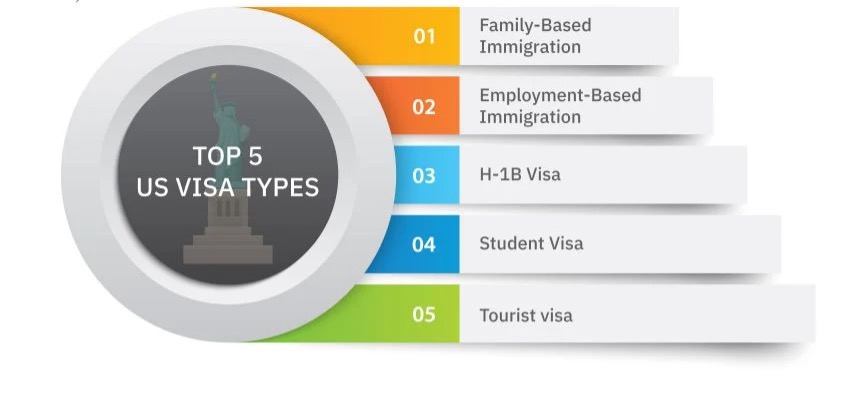
Your Ultimate Guide to U.S. Visa Categories
Navigating the U.S. visa system can be complex due to the multitude of available visa types, each serving different purposes and catering to various needs. Whether you’re planning to visit, study, work, or live permanently in the United States, understanding which visa category best fits your situation is crucial. This comprehensive guide will walk you through the primary U.S. visa categories, providing essential details on each.

Non-Immigrant Visas
Non-immigrant visas are for individuals who wish to enter the United States on a temporary basis for tourism, business, medical treatment, or certain types of work or study.
Tourist and Business Visas
- B-1 Visa (Business Visitor)
- For individuals visiting the U.S. for business purposes, such as attending conferences, negotiating contracts, or consulting with business associates.
- B-2 Visa (Tourist Visitor)
- For tourists, individuals visiting friends or relatives, and those seeking medical treatment.
Work Visas
- H-1B Visa (Specialty Occupations)
- For professionals in specialty occupations requiring a higher education degree or equivalent experience.
- H-2A Visa (Temporary Agricultural Workers)
- For temporary or seasonal agricultural work.
- H-2B Visa (Temporary Non-Agricultural Workers)
- For temporary or seasonal non-agricultural work.
- L-1 Visa (Intra-company Transferee)
- For employees transferring from a foreign branch of a company to a U.S. branch.
- O-1 Visa (Individuals with Extraordinary Ability or Achievement)
- For individuals with extraordinary ability in sciences, arts, education, business, athletics, or extraordinary achievements in film and television.
- P Visas (Athletes, Artists, and Entertainers)
- P-1 for athletes and entertainment groups, P-2 for artists in exchange programs, and P-3 for culturally unique performers.
Study and Exchange Visas
- F-1 Visa (Academic Student)
- For students attending academic programs or English language programs.
- M-1 Visa (Vocational Student)
- For students attending vocational or non-academic programs.
- J-1 Visa (Exchange Visitor)
- For participants in approved exchange programs, including students, trainees, teachers, and researchers.
Other Non-Immigrant Visas
- E-1 Visa (Treaty Traders)
- For nationals of countries with which the U.S. maintains treaties of commerce and navigation.
- E-2 Visa (Treaty Investors)
- For nationals of treaty countries investing a substantial amount of capital in a U.S. business.
- TN Visa (NAFTA Professionals)
- For Canadian and Mexican citizens in certain professional occupations under the North American Free Trade Agreement (NAFTA).
Immigrant Visas
Immigrant visas are for individuals who intend to live permanently in the United States.
Family-Based Immigrant Visas
- Immediate Relative Visas (IR)
- For spouses (IR-1), unmarried children under 21 (IR-2), parents of U.S. citizens (IR-5), and other immediate family members.
- Family Preference Visas (F)
- For other family relationships, including F-1 (unmarried adult children of U.S. citizens), F-2 (spouses and children of permanent residents), F-3 (married children of U.S. citizens), and F-4 (siblings of U.S. citizens).
Employment-Based Immigrant Visas
- EB-1 Visa (Priority Workers)
- For individuals with extraordinary ability, outstanding professors and researchers, and multinational executives and managers.
- EB-2 Visa (Professionals with Advanced Degrees or Exceptional Ability)
- For professionals holding advanced degrees or possessing exceptional ability.
- EB-3 Visa (Skilled Workers, Professionals, and Other Workers)
- For skilled workers with at least two years of experience, professionals with a bachelor's degree, and other workers performing unskilled labor.
- EB-4 Visa (Special Immigrants)
- For religious workers, employees of U.S. foreign service posts, retired employees of international organizations, and other special categories.
- EB-5 Visa (Immigrant Investor)
- For investors who invest at least $900,000 in a new commercial enterprise that creates or preserves 10 full-time jobs for qualified U.S. workers.
Diversity Visa Program
- Diversity Immigrant Visa (DV)
- Commonly known as the Green Card Lottery, this program provides a limited number of visas each year to people from countries with low rates of immigration to the U.S.
Humanitarian Visas
- Refugee and Asylum Status
- For individuals fleeing persecution or who have suffered persecution in their home countries due to race, religion, nationality, political opinion, or membership in a particular social group.
- U Visa (Victims of Criminal Activity)
- For victims of certain crimes who have suffered substantial mental or physical abuse and are helpful to law enforcement or government officials in the investigation or prosecution of criminal activity.
- T Visa (Victims of Human Trafficking)
- For victims of severe forms of trafficking in persons who have complied with any reasonable request from a law enforcement agency for assistance in the investigation or prosecution of human trafficking.
Conclusion
Understanding the various U.S. visa categories is the first step in your immigration journey. Each visa type has its own set of requirements and application procedures, so it’s important to carefully research and choose the one that best fits your purpose of travel. Consulting with an immigration lawyer can also provide personalized guidance and increase your chances of a successful application.
Embarking on the process of obtaining a U.S. visa can be daunting, but with the right information and preparation, you can navigate the system more confidently and achieve your immigration goals.
Related posts
-
In difficult times, fashion is always outrageous.
Lorem ipsum dolor consectetur adipiscing elit finibus purus..
-
We must never confuse elegance with snobbery.
Lorem ipsum dolor consectetur adipiscing elit finibus purus..
-
Elegance is not standing out, but being remembered.
Lorem ipsum dolor consectetur adipiscing elit finibus purus..


